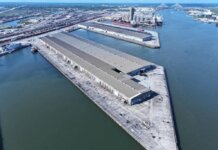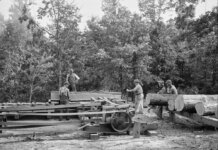
The U.S. government declared Mobile to be the most overcrowded city in America in 1943. In less than two years, the population of the Port City had risen 60%, from 78,000 to 125,000. Sales on consumable goods rose 40%. Writer John Dos Passos described Mobile as if it were in the midst of a human hurricane, “trampled and battered … like a city that’s been taken by storm.”
Wartime mobilization was, of course, the reason for the population boom. Men and women flocked to the city seeking good-paying jobs that were contributing to the cause. For many of them — and certainly for the city itself — those hectic years were defining ones.
Mobile was well positioned for the growth when war came. A new aluminum plant, improved state docks and the establishment of an Army Air Force supply base along the waterfront all enticed war workers. But the city’s largest wartime employer had older roots. What started out as a relatively small shipyard three decades earlier contributed mightily to the Allied victory.
In 1916, David R. Dunlap, president of the Alabama Iron Works, proposed a new venture with his cousin George H. Dunlap, who owned Mobile Marine Ways. They combined their resources and acquired the Ollinger & Bruce Shipbuilding Co., along with a boiler works, to create a large maritime construction and repair facility. The Dunlaps named their new enterprise the Alabama Dry Dock & Shipbuilding Company (ADDSCO). With an initial capitalization of more than $500,000, it was built to last.
Slowly, ADDSCO transformed Pinto Island — located across the Mobile River from the downtown docks — into a Gulf Coast behemoth with several dry dock slips, warehouses, water towers and offices.
The new shipyard’s contributions to World War I were few but included a 10,000-ton minesweeper and a few wooden and steel ships. Other early projects included barges for use by the Panama Canal Commission and the Tennessee Coal, Iron & Railroad Co. for its routes along the Black Warrior River.
In 1941, ADDSCO workers completed their largest project to date: construction and installation of the steel sections for the underwater Bankhead Tunnel connecting the shores of Mobile Bay for automobile traffic. Complex as it was, the tunnel project could have never prepared ADDSCO for what came later that same year when America entered World War II.

Thirty thousand souls soon worked for ADDSCO. One of their main tasks was constructing 21,000-ton cargo vessels called Liberty Ships, each stretching just over 500 feet in length. Here was David Dunlap’s vision come true, a shipyard capable of constructing several of these hulking vessels at the same time, stem to stern, start to finish. One employee described the typical, seven-day workweek: “Twelve hours, fives days a week. Ten hours on Saturday. On Sunday, when you only worked eight hours, you felt like you’d had a week off.”
Black workers were initially hired only in support roles. Southern social norms were fully in force on the shipyard. There were segregated ferries and segregated pay lines. By 1943, ADDSCO employed about 7,000 African Americans, among them Herbert Aaron, a boilermaker’s assistant whose young son, Henry, honed his baseball skills at Mobile’s sandlots.
In May 1943, after six months of foot-dragging that endangered its federal contracts, ADDSCO officials promoted a dozen African American men to welders on an overnight shift. White employees arriving for work the following morning reacted violently and threw the shipyard into a race riot that slowed production for several days. The following year, a crew comprised entirely of African Americans set a new ADDSCO record, constructing a Liberty Ship in just 79 days. As the tanker slid into the water with a thunderous splash, the workers paused only for a moment and then began anew.
During the war, ADDSCO employed approximately 2,500 women, including several hundred as welders who would have fit the “Rosie the Riveter” mold to perfection. They included Effie Keller of Fairhope, who started as an assistant in the welding department at 60¢ an hour. When she left two years later her salary had doubled and Keller was certified as a first-class pipefitter.

ADDSCO’s contribution to the war effort included 20 Liberty Ships, more than 100 other tanker types and some 3,000 repair jobs. Once victory came, the tide of war workers quickly receded from the Port City. Ninety thousand temporary residents were gone by the summer. The shipyard that once teemed with people now employed a comparatively scant 8,500. Layoffs and draw-downs continued apace, at ADDSCO and elsewhere. “What are the jobs?” mused a local labor leader, when thinking about the future of Mobile’s postwar economy. “Can we make a baker, a policeman or a laundry worker out of a first-class pipefitter, welder or plumber?” Time would tell.
Repairs were the primary work of the shipyard until the late 1960s when it received a Navy contract to build several rescue ships, followed soon thereafter by construction of the George Wallace Tunnel on Interstate 10. On a smaller scale, the company built semi-submersible oil platforms for use in the Gulf. ADDSCO closed in 1988. At the time, the company employed 400 workers. Other businesses that have since occupied the Pinto Island property include Atlantic Marine, BAE Systems and Alabama Shipyard.
Most of the WWII-era vessels built at ADDSCO were scrapped long ago. Little remains of the infrastructure that transformed Pinto Island and made Mobile into a “War Town.” More broadly, however, ADDSCO ushered in a new era of largescale maritime industry in Mobile, the effects of which are still an important part of the local economy.
From high above the Port City today, one can see a similar scene to the one John Dos Passos wrote of as he departed the downtown office of a federal contract overseer: “Across a welter of sunblackened roofs we can see in the slanting afternoon sunlight the rows of great cranes and the staging and the cradled hulls and beyond, in the brown strip of river, packed rows of new tankers…. In spite of turmoil and confusion, ships are getting built, ships, ships, ships.”
Historian Scotty E. Kirkland is a freelance contributor to Business Alabama. He lives in Wetumpka.
This article appears in the May 2025 issue of Business Alabama.



